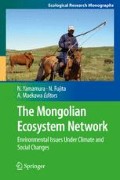Abstract
Mongolian pastoralism is characterized by its high mobility, as is reflected in its two most distinctive features as a husbandry system: one is the high ratio of castrated males in herds, and the other is the multiple uses of diverse livestock species. It has functioned as more than a subsistence economy, having lent economic support to the state’s military. These characteristics have arisen because of adaptations to both natural and social environments. This pastoral system has been transformed into a rather pure form of animal husbandry as a result of the demilitarization of the state and the program of modernization introduced by the socialist regime in the twentieth century. Furthermore, as Mongolia underwent its transition into a market economy in the 1990s, the economic disparities among regions and households consequently expanded. In response to this novel situation, herders became highly mobile, which gave them more profitable access to both natural and social resources.
This article is based on the paper in E-journal GEO published by The Association of Japanese Geographers, vol. 2 (1)34–42, 2007, in Japanese.
Access this chapter
Tax calculation will be finalised at checkout
Purchases are for personal use only
Notes
- 1.
This article is based on the paper in E-journal GEO published by The Association of Japanese Geographers, vol. 2 (1)34–42, 2007, in Japanese.
References
Bazargur D. Chinbat B. & Shiirev-Aduya, S (1989) Bugd nairamdakh mongol ard ulsiin malchidiin nuudel (Nomadic movements in the MPR). Ulaanbaatar.
Dahl G, Hjort D (1976) Having herds. Stockholm: University of Stockholm Press.
Erdenebaatar, B. (1996). Socio-economic aspects of the pastoral movement patterns of Mongolian herders. In Humphrey C, Sneath D (eds) Culture and environment in Inner Asia, vol. 1. Cambridge: White Horse Press, pp. 56–110.
Fujita, N. (2003). Sougen shokubutsu no seitai to yuubokuchi no jizokuteki riyou–shokubutsugaku kara mita mongoru kougen (Plant ecology of grasslands and sustainable use of nomadic pasturage–a botanical view of the Mongolian plateau). Kagaku 73(5):563–569.
Goto, T. (1968). Nairiku ajia yuubokumin shakai no kenkyuu (Research on the Nomadic Societies of Inner Asia). Tokyo: Yoshikawa Kobunkan.
Humphrey, C. & Sneath, D. (1999). The End of Nomadism? Durham, NC: Duke University Press.
Konagaya, Y. (1999). Sougen no kuni wo kaetta joseitachi (Women who changed the country of grasslands). In K. Sachiko & Y. Yuko (Eds.) Shakai henyou to josei– jenda no bunka jinruigaku (Social Change and Women– the anthropology of gender). (pp. 4–35). Kyoto: Nakanishiya Shuppan.
Konagaya, Y. (2003). Umarekawaru yuubokuron– hito to shizen no aratana kankei wo motomete (The study of nomadism reborn– searching for a new relationship between people and nature). Kagaku 73(5):520–524.
Konagaya, Y. (2004). Mongoru no nijuuseiki– shakai shugi wo ikita hitobito no shougen (Mongolia’s 20th Century– testimony of the people who lived under socialism). Tokyo: Chuo Koron Shinsha.
Konagaya Y. (2005). Sekai no shokubunka mongoru (World Food Cultures: Mongolia). Tokyo:Nosangyoson Bunka Kyokai.
Maiskii IM (1921) Sovremennaya Mongoliya (Modern Mongolia). Irkutskoe otd-nie, Irkutsk.
Matsubara, M. (1983) Yuboku no sekai (The world of nomadism). Tokyo: Chuo koron sha.
Ministry of Foreign Affairs (Japan) (1962) Asia Bureau China Section. Mongoru jinminkyowakoku (sendenin hikkei) Vol. 1. (Mongolian People’s Republic, public relations officer handbook). Ministry of Foreign Affairs.
National Statistical Office. (2003). Mongolian Statistical Yearbook 2002. Ulaanbaatar: National Statistical Office.
National Statistical Office. (2006). Mongolian Statistical Yearbook 2005. Ulaanbaatar: National Statistical Office.
Shinoda, M. & Morinaga, Y. (2005). Mongorukoku ni okeru souki saigai keikai sisutemu no kouchiku ni mukete (Towards construction of a disaster early warning system in Mongolia), Chirigaku Hyouron 78(11):928–950.
Simukov, A.D. (1935). Pastbisha Mongoliskoi Narodnoi Respubliki (Pastoral Movement in Mongolia), Sovremennaya Mongoliya 1935:2(9),76–89.
Tani, Y. (1984). Hitsuji ni totte bokufu to ha nanika (What is the shepherd for sheep?). In Y. Nagata & M. Matsubara (Eds.), Isuramu sekai no hitobito - 3 Bokuchikumin (People of the Islamic world - 3 Pastoralists), Toyo Keizai. (pp. 70–108).
Toshimitsu (Konagaya), Y. (1983). Otoru nouto– mongoru no idou bokuchiku wo megutte (“Otor notes– concerning Mongolia’s mobile animal husbandry”). Jinbun Chiri, 35(6):548–559.
Toshimitsu (Konagaya), Y. (1986). Mongoru ni okeru kachiku yotaku no kankou (Livestock banking customs in Mongolia). Shirin 69:770–794.
Umesao, T. (1976). Shuryou to yuuboku no sekai (The World of Hunting and Nomadism). Tokyo: Kodansha.
Vreeland, H.H. (1957). Mongol Community and Kinship Structure. New Haven, CT: Human Relations Area Files.
Author information
Authors and Affiliations
Corresponding author
Editor information
Editors and Affiliations
Rights and permissions
Copyright information
© 2013 Springer Japan
About this chapter
Cite this chapter
Konagaya, Y., Maekawa, A. (2013). Characteristics and Transformation of the Pastoral System in Mongolia. In: Yamamura, N., Fujita, N., Maekawa, A. (eds) The Mongolian Ecosystem Network. Ecological Research Monographs. Springer, Tokyo. https://doi.org/10.1007/978-4-431-54052-6_2
Download citation
DOI: https://doi.org/10.1007/978-4-431-54052-6_2
Published:
Publisher Name: Springer, Tokyo
Print ISBN: 978-4-431-54051-9
Online ISBN: 978-4-431-54052-6
eBook Packages: Biomedical and Life SciencesBiomedical and Life Sciences (R0)

